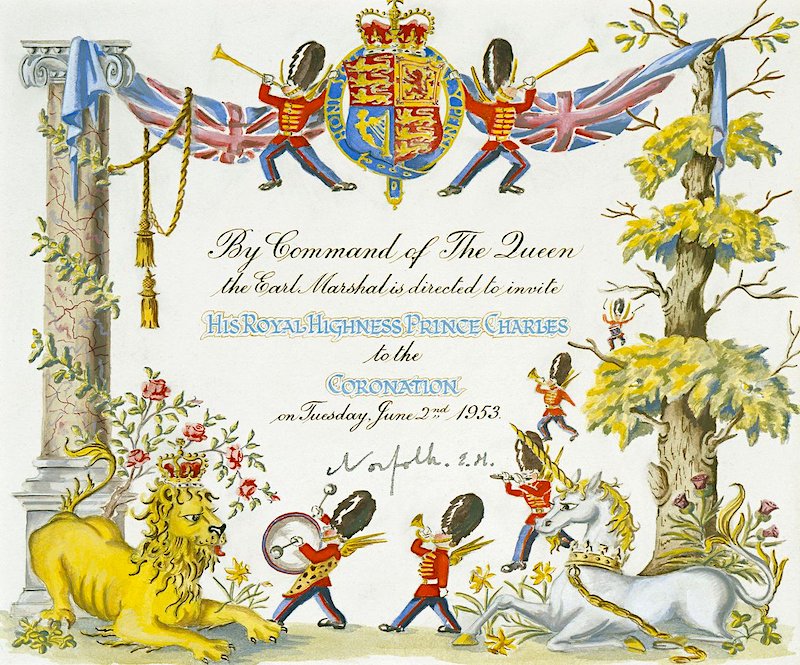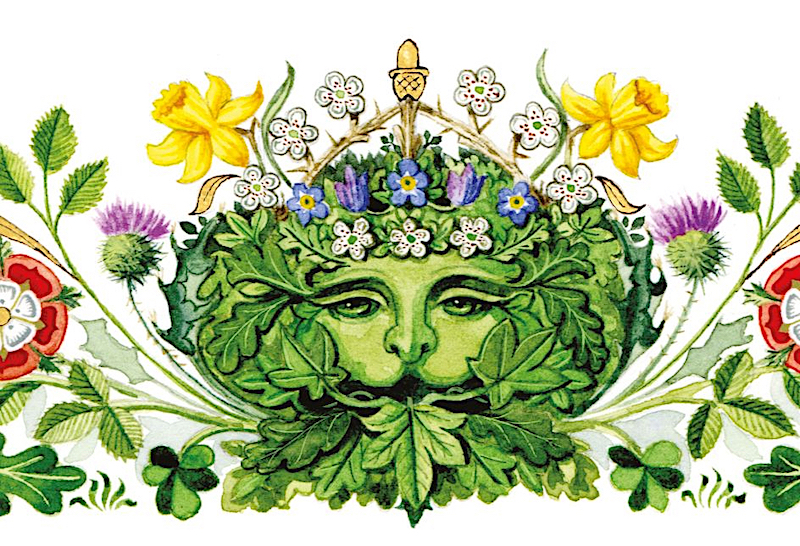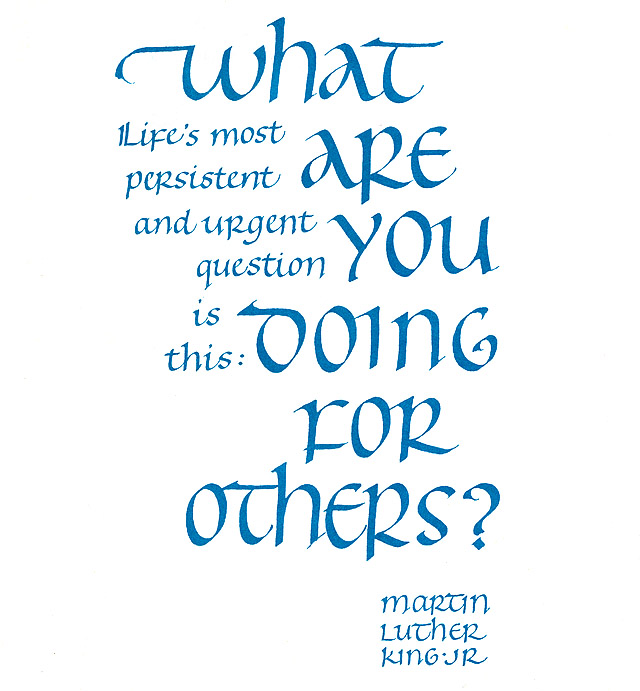A royal coronation, traditional arts of calligraphy and illumination, mythic overtones – any of these would have been enough to catch my interest. But throw in a Green Man and I’m intrigued beyond measure.
My heart went pitter-pat when I saw the invitation art for the upcoming coronation of England’s new king and his queen. With an illuminated border redolent with the spirit of medieval illuminated manuscripts, it features a lavish panoply of flowers, birds and bees, all rich with symbolism, cavorting around the relatively spare calligraphy. And centered at the bottom, the ground of the work, is a luscious green man with a benevolent face festooned with foliage and crowned with daffodils, hawthorn and a single erect acorn.

The artist, Andrew Stewart Jamieson, a classically trained scribe, illuminator and heraldic artist, worked in utter secrecy for a month to produce this commission on time. One might suppose that he was under the direction of his client, in this case, the King of England, or perhaps the Duke of Norfolk, whose signature and shield appear in the lower right of the text and whose job it is to arrange such details about events of state like coronations. But the design is his own, accepted as he envisioned and drafted it. Andrew’s website is breathtakingly beautiful. He is a Brother of the Art Workers Guild, of which the new king is also an honorary member.
Everything in the border is symbolic, from the bumblebee to the elaborate arms of both Charles and Camilla. The traditional flowers of the four countries of the Isles where the monarch rules are represented by the daffodil for Wales, the thistle for Scotland, the shamrock for Ireland (and how contentious that still is) and the red and white Tudor rose for England, harking back of the War of the Roses between the houses of Lancaster and York. The verdant border represents an English meadow with its many cornflowers, primroses, violas, dianthus, forget-me-nots, strawberries and lily of the valley for the late Queen, and a sprig of rosemary for remembrance, calling to mind the Bard of England, Shakespeare and his Ophelia.
I’m especially fond of the letter “C” with the knot work joining two stems, perhaps for the two names of Charles and Camilla. “C” is naturally one of my favorite letters to decorate.
 Many observers have parsed out the meaning of every flower and critter in this border, for example here and here.
Many observers have parsed out the meaning of every flower and critter in this border, for example here and here.
Much as I love these botanical illustrations, it is that friendly green man who has caught and held my imagination. Described by Buckingham Palace as a symbol of new beginnings, this frankly pagan presence points to something a bit more mystical. Green men appear in most medieval churches throughout England and Europe, living side by side with the more ecclesiastical imagery one would expect in a Christian church. This most curious of faces peered down at churchgoers in the centuries when the old ways of the land existed side-by-side with the new religion preached from the pulpits. For the largely illiterate populace of the day, the green man was a presence fully understood by its imagery alone.
And now he gazes out at us from the coronation invitation, anchoring the whole design. What does it mean?

Plenty of commentary has poked fun at the green man’s appearance, speculating that perhaps a Maypole will appear outside of Westminster Abbey on coronation day, that Charles might ride in on a hobby horse or dance with white handkerchiefs before the altar as English Morris dancers do, or that licentious coupling will reign in the precincts of the event.
Yes, it is easy to make fun of pagans, and we are the first to mock ourselves for the silliness of rituals, especially if we are of English heritage and embarrassed about anything that might make us look foolish. Even the Arch Druid of England, Philip Carr-Gorman, will laugh at himself, as he did a few winter solstices back in the Times.
The vegetal face sprouting leaves and vines went rarely remarked upon for centuries, until a noble lady in 1939 “named” such visages green men, giving rise to the fiction that the green man is a figment of early 20th century imagination. This conveniently ignores the multitude of green men on buildings and on manuscript pages, reaching back in provenance to Roman times and probably before. There is plenty of visual and literary evidence that the green man existed in British folkloric traditions going back at least to the sixteenth century. In architecture he was long referred to as a “foliate head” and in other contexts as the “Wild Man.” That he represents wild nature is clear, but that some pundits dismiss his existence as nonsense, balderdash, or a joke is more a reflection of their own desire to not “go into depth” and thereby sidestep his significance.
 Given the symbolism of everything else in the illustrated border I think there is something more here.
Given the symbolism of everything else in the illustrated border I think there is something more here.
The obvious explanation is that Charles clearly has a soft spot for the green man because of his lifelong advocacy for environmental issues. The reappearance of the green man in our cultural consciousness represents opposition to the destruction of forests and thence to many other devastations. Charles was still quite a young man when he publicly addressed the issue in 1970, the same year awareness of earth concerns prompted not only the first Earth Day in the United States, but also awakened a worldwide consciousness of our fragile planet, sparked by one of the first images of Earth from the moon, taken by an astronaut on Apollo 8 in 1968.
The news is full of woe about our sorry abuse of the earth. The flowers and animals in the border of this invitation may seem frivolous and trite, but they won’t be if they disappear from a scorched or iced landscape brought on by climate change. They are the symbols of our most dear and precious earth. Spare a moment for the courage of an event that gives a nod to our oldest and most universal worship, the rituals of the land without which none of our other culturally generated religions or social institutions will survive. Flower, birds, bees – they are the very fabric of our life on our Mother Earth.
 One writer’s snide remark that the invitation “seems to be licensing another kind of coronation, one that is deconsecrated, even pagan,” misses the mark by a mile. Pagans hold the Earth and all her creatures and flowers sacred, and by our rituals “consecrate, anoint, and dedicate” ourselves to her protection and love. The green man is not pagan fluff, but a very ancient symbol of care for the spirit of the earth.
One writer’s snide remark that the invitation “seems to be licensing another kind of coronation, one that is deconsecrated, even pagan,” misses the mark by a mile. Pagans hold the Earth and all her creatures and flowers sacred, and by our rituals “consecrate, anoint, and dedicate” ourselves to her protection and love. The green man is not pagan fluff, but a very ancient symbol of care for the spirit of the earth.
Charles has continued to profoundly nurture the old ways with his support of traditional handicrafts, small-scale agriculture, and creative expression among young people, to name a few of his endeavors. He is also a student of history and his fondness for the oak leaves and acorns which appear with the green man point to the veneration of the “royal oak” at Boscobel which gave shelter to a previous king, Charles II, in flight from Oliver Cromwell’s soldiers.
The image of the green man here also seems a gesture toward the oldest way of sovereignty. The king is marrying the land.
There is something mythic about a coronation. These old ceremonies touch ancient traditions and deep history. They stir archetypal memories and reach out to touch circular time, the agricultural calendar that follows the solar year’s ever-returning seasons, and the lunar calendar which waxes and wanes without fail.
 The coronation ceremony is happening not only at the full moon but also during the tide of Beltane. Otherwise known as May Day, this is the blooming time when the green earth welcomes the waxing sun’s warmth with a profusion of color and fertility. In the folklore of this time, lovers traditionally take to the woods on May Eve to couple, and at dawn bring home hawthorn blossoms to garland the doors of their neighbors. It is the holy time when the sun and the earth bends toward one another in a rite of sacred marriage. The green man and the goddess unite: the goddess the symbol of the land, and the green man her consort.
The coronation ceremony is happening not only at the full moon but also during the tide of Beltane. Otherwise known as May Day, this is the blooming time when the green earth welcomes the waxing sun’s warmth with a profusion of color and fertility. In the folklore of this time, lovers traditionally take to the woods on May Eve to couple, and at dawn bring home hawthorn blossoms to garland the doors of their neighbors. It is the holy time when the sun and the earth bends toward one another in a rite of sacred marriage. The green man and the goddess unite: the goddess the symbol of the land, and the green man her consort.
The sacred marriage of the King and Sovereignty is very old, stretching from the ancient Mediterranean cultures to appear in some of the oldest stories associated with The Matter of Britain, the Arthurian story cycle which treats memorably of kingship, surrogates and rivals, and women who confer power and shapeshift between being beautifully young and frighteningly old.
The king is bit long in the tooth to be a young and lusty Green Man. But he is still fertile with ideas. Or he may be honoring his son William, current Prince of Wales and next in line to the throne, who married his love Kate Middleton at Beltanetide in 2011.
Will a Maypole appears outside Westminster Abbey in celebration of this Beltanetide coronation? I can only hope.
As a kind of postscript, I will leave you with this tender image. In the vast coverage leading up to the coronation, I feel perhaps most softhearted for this hand-lettered, illustrated “one-off” invitation made for the four-year-old Charles when his mum was crowned in 1953. There is even a touch of the wildwood encircling the lion’s English pillar, while the wildish tree of the unicorn is a symbol of Scotland, showing perhaps his lady mother’s deep fondness for the untamed north. I’ve no doubt receiving this charmingly decorated invitation instilled a deep love of the traditional arts of calligraphy and illumination in the boy-soul of the new king, and now he has come full circle to give all of us the same delight in the lovely painting on his own coronation invite.

Aside from the links in the text here were my most helpful sources:
Two very well-researched articles on the Library of Congress website were invaluable for their comprehensive research and links to validating archival materials.
William Anderson’s & Clive Hick’s Green Man – the Archetype of our Oneness with the Earth, published in 1990, was available to me on the altogether invaluable Internet Archive here. I bought a used copy, too (recycling!), from my one of my favorite vendors of secondhand books, Better World Books.
And lastly, my deepest thanks to friend Patricia Hayward in England for sending me news of the invite and later supplying the name of the above book as the most thorough and sensitive of all the material out there on the green man. She and her husband Anthony documented the Victorian revival of medieval style on more than a hundred buildings and homes and published them in very limited edition entitled The Green Men of Birmingham in 2000. You can find a copy of that rare book in The British Library and Trinity College Library in Dublin. Perhaps the King still has the copy that was sent to him too.





Wow, Cari! Thank you for this wonderful article. I have new respect for this royal coronation. Love the detail you put into your writing.
Sherrie, I’m so pleased you enjoyed it! The layers just kept coming. The last bit came when a customer from years ago wanted one of my old wedding certificate prints for her brother’s wedding, and it all just snapped into focus.
Thanks for the informative post about the traditions underlying the invitations. Beautiful calligraphy and illumination!